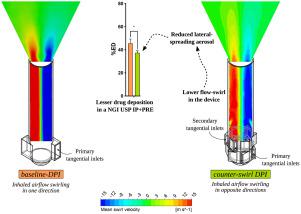International Journal of Pharmaceutics ( IF 5.3 ) Pub Date : 2023-12-09 , DOI: 10.1016/j.ijpharm.2023.123694 Vishal Chaugule 1 , Larissa Gomes Dos Reis 2 , David F Fletcher 3 , Paul M Young 4 , Daniela Traini 5 , Julio Soria 1

|
A swirling airflow is incorporated in several dry powder inhalers (DPIs) for effective powder de-agglomeration. This commonly requires the use of a flow-straightening grid in the DPI to reduce drug deposition loss caused by large lateral spreading of the emerging aerosol. Here, we propose a novel grid-free DPI design concept that improves the aerosol flow characteristics and reduces the aforementioned drug loss. The basis of this design is the implementation of a secondary airflow that swirls in the opposite direction (counter-swirl) to that of a primary swirling airflow. In-vitro deposition, computational fluid dynamics simulations and particle image velocimetry measurements are used to evaluate the counter-swirl DPI aerosol performance and flow characteristics.
In comparison with a baseline-DPI that has only a primary swirling airflow, the counter-swirl DPI has 20% less deposition of the emitted drug dose in the induction port and pre-separator of a next generation impactor (NGI). This occurs as a result of the lower flow-swirl generated from the counter-swirl DPI which eliminates the axial reverse flow outside of the mouthpiece and substantially reduces lateral spreading in the exiting aerosol.
Modifications to the counter-swirl DPI design were made to prevent drug loss from the secondary airflow tangential inlets, which involved the addition of wall perforations in the tangential inlets and the separation of the primary and secondary swirling airflows by an annular channel. These modified DPI devices were successful in that aspect but had higher flow-swirl than that in the counter-swirl DPI and thus had higher drug mass retained in the device and deposited in the induction port and pre-separator of the NGI. The fine particle fraction in the aerosols generated from all the counter-swirl-based DPIs and the baseline-DPI are found to be statistically similar to each other.
中文翻译:

干粉吸入器的反涡流设计理念
一些干粉吸入器 (DPI) 中融入了旋转气流,可有效地使粉末解聚。这通常需要在 DPI 中使用气流矫直网格,以减少由出现的气溶胶横向扩散引起的药物沉积损失。在这里,我们提出了一种新颖的无网格 DPI 设计概念,可以改善气溶胶流动特性并减少上述药物损失。该设计的基础是实现与主旋流气流相反方向(逆旋流)旋流的辅助气流。体外沉积、计算流体动力学模拟和粒子图像测速测量用于评估反旋DPI 气溶胶性能和流动特性。
与仅具有主旋流气流的基线 DPI相比,反旋流DPI 在下一代冲击器 (NGI) 的吸入口和预分离器中的排放药物剂量沉积减少了 20%。这是由于反涡流DPI 产生的较低流动涡流的结果,它消除了吸嘴外部的轴向反向流动,并大大减少了排出气溶胶的横向扩散。
对反旋流DPI 设计进行了修改,以防止药物从辅助气流切向入口损失,其中涉及在切向入口中添加壁穿孔以及通过环形通道分离主旋流和辅助旋流气流。这些改进的 DPI 装置在这方面是成功的,但具有比反涡流DPI 更高的流动涡流,因此具有更高的药物质量保留在装置中并沉积在 NGI 的导入口和预分离器中。发现所有基于反旋流的 DPI 和基线 DPI产生的气溶胶中的细颗粒部分在统计上彼此相似。

















































 京公网安备 11010802027423号
京公网安备 11010802027423号